In the vast ocean of content that floods the internet every day, it’s easy for your voice to get lost. With millions of blogs, articles, and videos competing for attention, how can you ensure that your content stands out? The answer lies in cornerstone content.
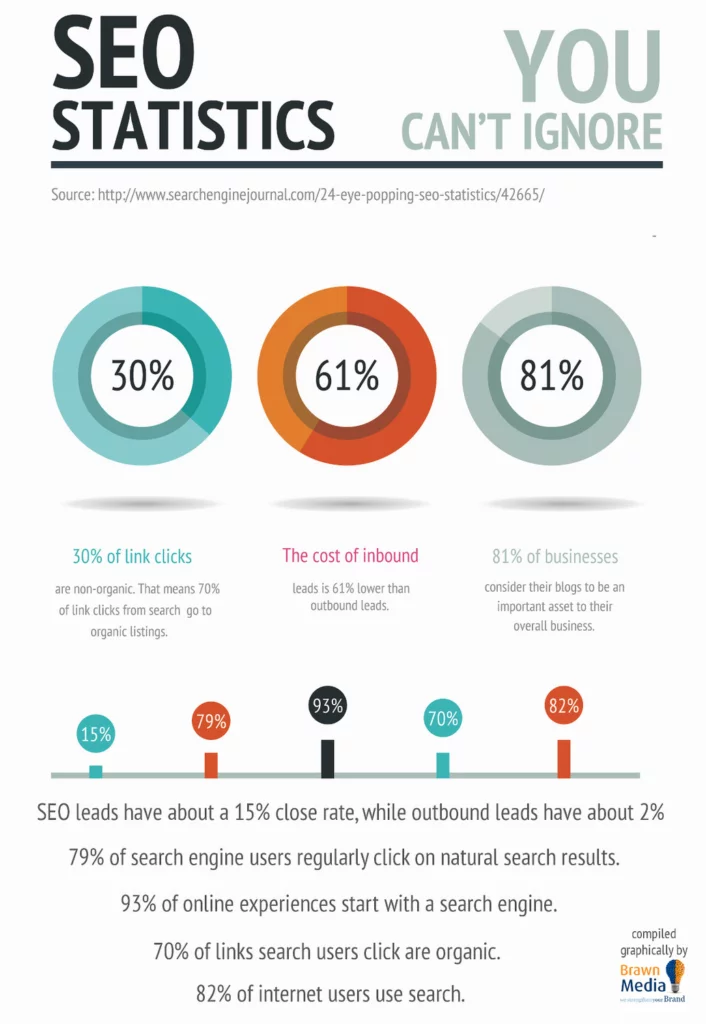
Cornerstone content serves as the foundation of your website. It’s the carefully crafted, comprehensive content that addresses the core topics of your niche or industry. Think of it as the cornerstone of a building – sturdy, essential, and able to support the entire structure.
What is Cornerstone Content?
Cornerstone content refers to the crucial, foundational pieces of your website’s content. These pages or articles serve as the bedrock of your overall content strategy, containing the most comprehensive, informative, and valuable information for your audience.
Learn about blogging techniques here.
Conceptualizing Your Content Strategy:
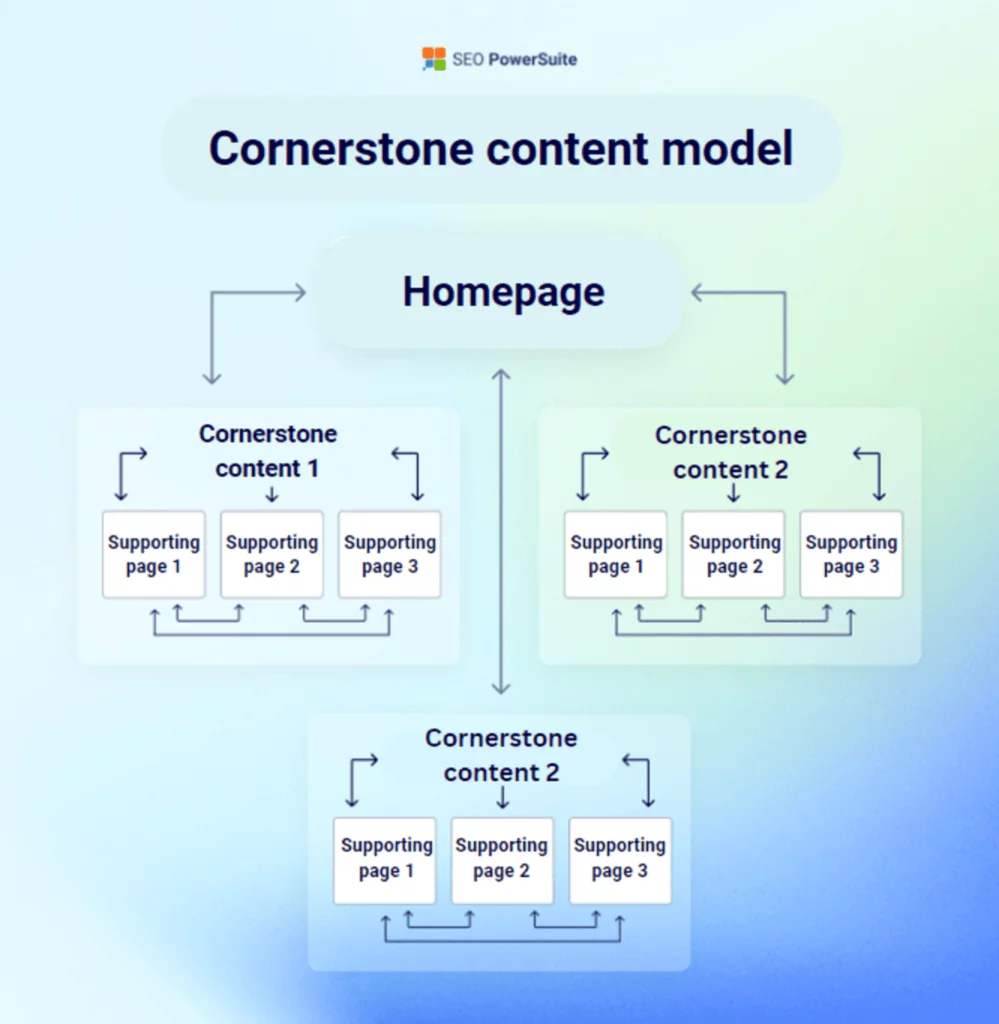
To visualize your content marketing strategy, consider it as a pyramid:
- Capstone: At the pinnacle of your pyramid are pages like your home page, pricing page, and product pages. These are the ultimate destinations where your audience completes a purchase or takes a desired action.
- Top (Cornerstone Content): Just below the capstone are your cornerstone content pieces. These pages are characterized by their informative, compelling nature and serve as the primary drivers of traffic to the decision-making pages above.
- Middle: Your mid-level content consists of supporting long-form guides and articles. These pieces complement your cornerstone content by providing related topics and driving SEO value to them.
- Bottom: Foundational blog posts and articles targeting long-tail keywords form the base of your pyramid. While essential, they primarily serve to support and complement your cornerstone content.
Key Features of Cornerstone Content:
- Informative and Comprehensive: Cornerstone content pieces offer in-depth information on crucial topics relevant to your audience.
- Highly Competitive: These pages are optimized to rank well in search results, competing for top positions with other authoritative content.
- Strategic Traffic Drivers: Cornerstone content directs traffic to key decision-making pages on your website, ultimately leading to conversions.
- Foundation of Content Strategy: They serve as the backbone of your content marketing efforts, providing a solid foundation for other content pieces to build upon.
Steps to Create Cornerstone Content:
Step 1: Identify the Main Topic and Keyword

Begin by identifying the main topic or theme around which your cornerstone content will revolve. This main topic will serve as the focus of your content and should align with the overarching theme of your website. While traditional keyword research may not be necessary for cornerstone content, it’s essential to select a primary keyword or head term that represents the main topic. For example, if your website focuses on pet care, your cornerstone keyword could be “cat health.”
Keep in mind that head terms like “cat health” may be highly competitive, making it challenging for newer websites to rank for them immediately. However, creating cornerstone content around such head terms is still valuable, as it establishes your authority in the niche and provides a foundation for targeting related long-tail keywords. Even if your cornerstone content doesn’t rank highly for the head term initially, it can still signal to search engines that you’re an authority on the topic, ultimately benefiting your overall SEO strategy.
While most websites typically require only one piece of cornerstone content, ensure that your chosen main topic accurately reflects the core focus of your website. For example, Copyblogger, a website specializing in content marketing, has cornerstone content pieces on topics like content marketing, search engine optimization, and copywriting. Select a head term that aligns with your website’s main theme and expertise.
Step 2: Map Out Various Additional Subtopics
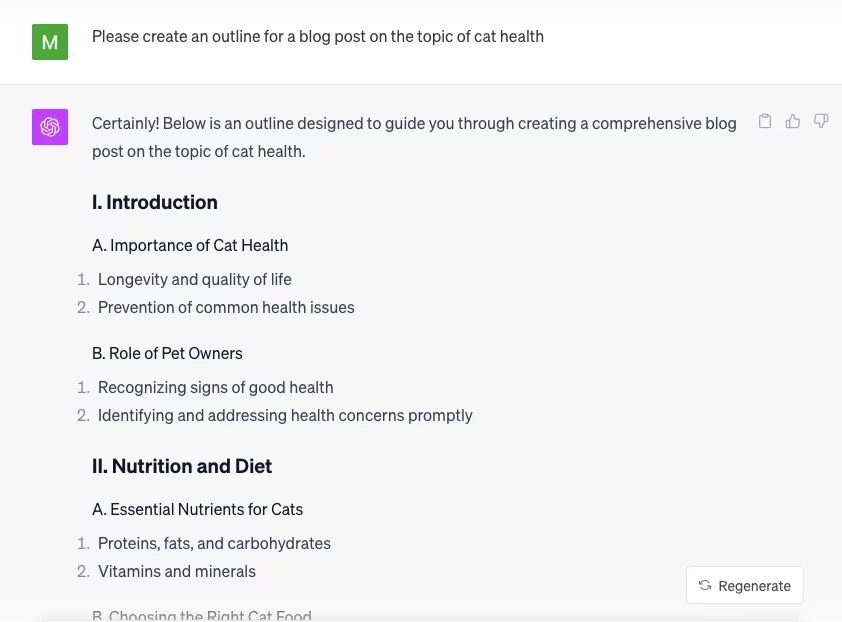
Once you’ve identified the main topic for your cornerstone content, the next step is to map out the various subtopics that will be covered within the piece. These subtopics provide a comprehensive overview of the main topic and address common questions and concerns related to it.
To begin, consider using tools like ChatGPT to assist you in building an initial outline for your content. For example, you can prompt ChatGPT to generate an outline for your article on “cat health.” While the generated outline may provide a solid foundation, it’s essential to review and edit it yourself to ensure it aligns with your specific goals and audience needs.
The outline should encompass key subtopics that someone searching for information on the main topic would want to know about. This may include sections such as “grooming and care,” “nutrition and diet,” “common health issues,” and “behavioral tips.” Each subsection should address important aspects related to the main topic, offering valuable insights and guidance to readers.
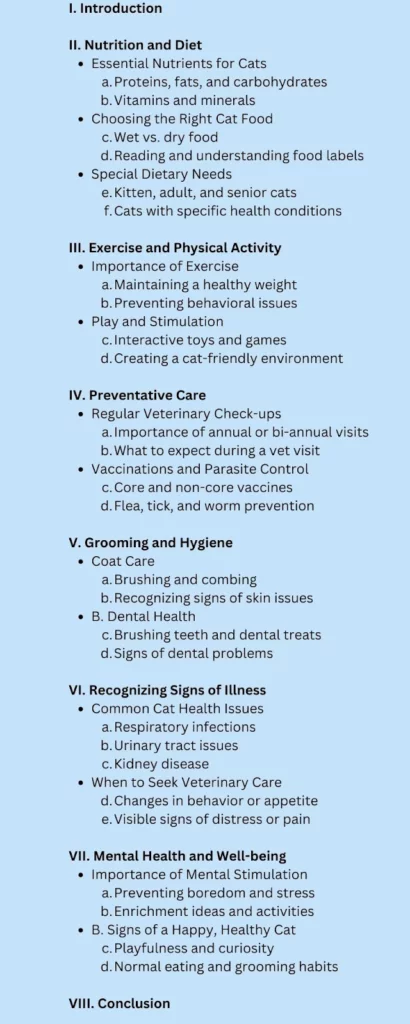
Keep in mind that the goal of cornerstone content is to provide a general overview of the topic, laying the groundwork for more in-depth discussions in future blog posts or articles. Therefore, each subtopic should be broad enough to cover essential information while also serving as a launching point for more detailed exploration in subsequent content pieces.
As you map out the subtopics, consider the needs and interests of your target audience. What questions or concerns are they likely to have about the main topic? By addressing these issues comprehensively within your cornerstone content, you can create a valuable resource that resonates with your audience and establishes your expertise in the field.
Step 3: Creating And Optimizing The Content
Now that you’ve outlined your cornerstone content and identified the main subtopics, it’s time to start crafting the actual content. Follow these steps to ensure your content is both high-quality and optimized for search engines:
- Incorporate the keyword strategically: Ensure the target keyword is included in the title tag and the opening paragraph of the content. This helps search engines understand the topic of your content and improves its visibility in search results.
- Provide unique value: Differentiate your content from competitors by offering unique insights, perspectives, or solutions to common problems. Aim to provide valuable information that goes beyond what’s already available in the SERPs.
- Use keyword optimization tools: Consider using tools like Surfer or Clearscope to identify relevant keywords and phrases to incorporate throughout your content. These tools can help optimize your content for search while maintaining its readability and relevance.
- Focus on breadth, not depth: Unlike standalone blog posts, cornerstone content should provide a broad overview of the main topic without delving too deeply into specific subtopics. Instead, use internal linking to guide readers to more detailed resources on each subtopic.
Internal linking is crucial for directing readers to related blog posts or articles within your website. This not only helps search engines understand the structure and hierarchy of your content but also encourages visitors to explore more of your site.

Ensure your cornerstone content is well-organized and easy to navigate by including a table of contents, sticky sidebar, and clear subheaders. These elements make it easier for readers to find the information they’re looking for and improve overall user experience.
Incorporate visual elements such as screenshots, graphics, and images to enhance readability and engagement. Break up long paragraphs with bullet points, and use bold or underline formatting to highlight important concepts.
By optimizing your cornerstone content for both search engines and user experience, you can create a valuable resource that attracts organic traffic, establishes your authority in the field, and encourages visitor engagement and retention.
Step 4: Promoting Cornerstone Content
Once your cornerstone content is published, the work isn’t over yet. It may take some time for your content to gain traction and start ranking for your target keywords, especially in competitive niches. However, there are strategies you can implement to promote your cornerstone content effectively:
- Build Backlinks: Backlinks from authoritative websites in your niche are crucial for improving the visibility and ranking of your cornerstone content. While active link building methods like paying for links are discouraged by Google, you can attract backlinks naturally by offering value to other websites. This could involve refreshing their outdated content, identifying broken links to similar content, or offering unique insights and data that others find valuable.
- Create Link-Worthy Content: Focus on creating content that naturally attracts backlinks. This could include incorporating new statistics or data, discussing case studies, or including quotes from industry experts. By offering valuable and unique content, you increase the likelihood of other websites linking to your cornerstone content.
- Build Genuine Relationships: Establishing genuine relationships with industry influencers and other website owners can lead to organic backlinks and collaborations. Offer to collaborate on content creation, sponsor events, or promote their content for free. Building real relationships fosters trust and can result in long-term partnerships and link opportunities.
- Leverage Influencer Marketing: Collaborate with influencers in your industry to promote your cornerstone content through their newsletters, social media channels, or other platforms. Influencers can help amplify your content to a larger audience and attract more engagement and backlinks.
- Focus on Business Goals: While metrics like brand awareness, organic traffic, and backlinks are important, don’t lose sight of the ultimate goal – building your business. Building genuine relationships and partnerships not only contribute to earning backlinks but also support broader business objectives in the long run.
Step 5: Content Updating And Refreshing
Even after publishing your cornerstone content, the work doesn’t stop. In fact, it’s essential to continuously update and refresh your content to keep it relevant and competitive in the ever-evolving landscape of the digital world.
- Adding Subtopic Coverage: As you create more blog posts targeting subtopics related to your main content, consider updating your cornerstone content with brief sections or internal links to these topics. This not only enhances the comprehensiveness of your main content but also helps it rank higher for longer tail keywords.
- Keeping Content Fresh: Regularly updating your content signals to search engines that it’s current and valuable. Search engines prioritize fresh content to provide users with the most relevant and up-to-date information. By making minor content refreshes, you ensure that your cornerstone content remains useful and appealing to both users and search engines.
- Eliminating Outdated Information: Over time, certain information in your cornerstone content may become outdated or irrelevant. It’s crucial to review your content periodically and remove any obsolete information. This helps maintain the credibility and accuracy of your content, improving user experience and search engine rankings.
- Adding New Information: Stay informed about developments and advancements in your industry or niche, and update your cornerstone content accordingly. Adding new insights, data, or examples keeps your content current and valuable to your audience. This demonstrates your expertise and authority in the subject matter, enhancing your credibility with both users and search engines.
- Utilizing Efficient Strategies: Embrace new tools and techniques that streamline the content creation and updating process. For example, leveraging AI tools like ChatGPT to generate outlines or optimize content can significantly improve efficiency and effectiveness. By staying updated on the latest trends and technologies, you ensure that your content remains competitive and impactful in the digital landscape.
Real Life Examples of Quality Cornerstone Content:
Example #1: Bankrate‘s Guide on Purchasing a House
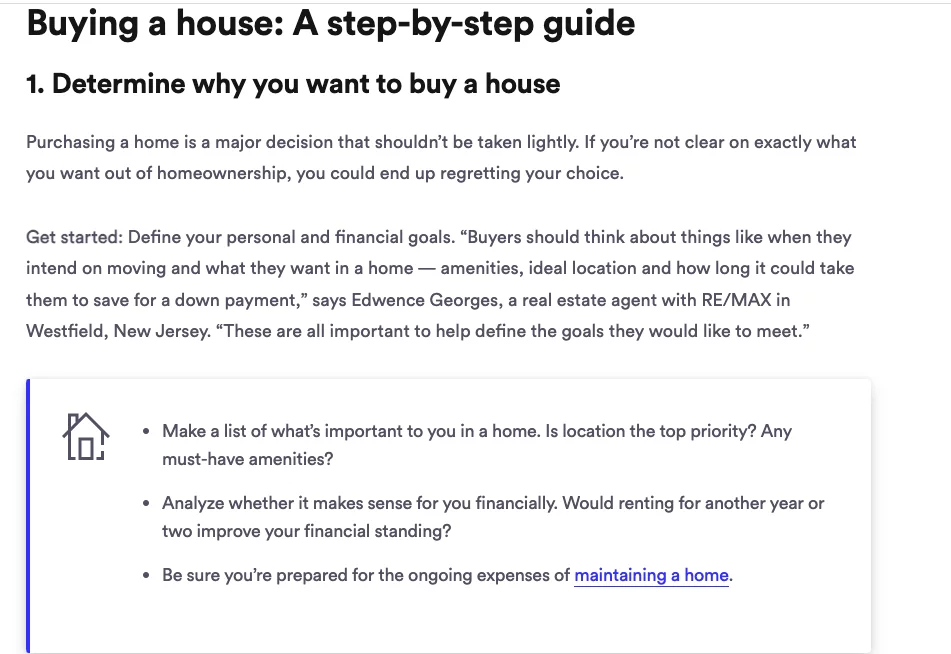
Bankrate, a renowned platform for financial education, strategically includes a cornerstone content page dedicated to the intricacies of purchasing a house. This comprehensive guide serves as a fundamental resource for individuals navigating the complexities of homeownership.
- User-Focused Design: Bankrate’s guide excels in user experience, offering an intuitive layout that enhances readability and navigation. Bullet-point lists are strategically incorporated under each subcategory, facilitating effortless scanning for readers seeking quick insights.
- Comprehensive Coverage: The guide provides in-depth coverage of various aspects related to buying a house, addressing critical considerations such as mortgage options, budgeting strategies, and negotiation tactics. By offering comprehensive information, Bankrate ensures that readers are equipped with the knowledge needed to make informed decisions throughout the home buying process.
- Strategic Internal Linking: A notable feature of Bankrate’s cornerstone content is its strategic use of internal links. These links seamlessly direct readers to more detailed blog posts on specific subtopics, such as home maintenance. By interconnecting related content within their website, Bankrate enhances the user’s journey, allowing them to explore additional resources for a deeper understanding of relevant subjects.
Example #2: Healthline’s Comprehensive Guide to the Ketogenic Diet
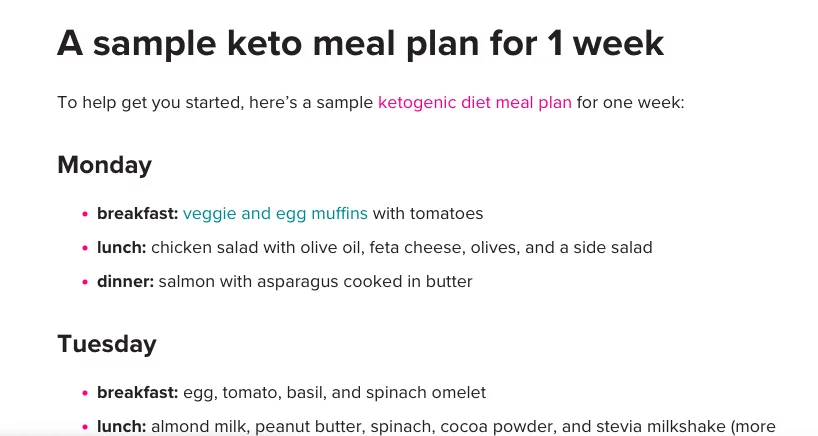
Healthline showcases an exemplary cornerstone content piece focusing on the ketogenic diet, demonstrating their commitment to providing authoritative health information. This comprehensive guide offers a wealth of information to individuals seeking to understand and adopt the ketogenic lifestyle.
- Comprehensive Coverage: Healthline’s guide delves into various aspects of the ketogenic diet, offering insights into its definition, mechanisms, dietary recommendations, and potential benefits and risks. From explaining the fundamental principles of ketosis to outlining practical tips for meal planning, the content caters to both novice learners and seasoned practitioners of the keto diet.
- Detailed Subsections: Each section of the guide is meticulously crafted to address specific facets of the ketogenic diet comprehensively. For instance, the section on sample diets provides readers with a glimpse into a typical day’s meal plan on a keto diet, while the discussion on benefits and risks offers a balanced perspective on the diet’s potential impact on health and well-being.
- Strategic Internal Linking: Healthline employs strategic internal linking to enhance the user experience and provide additional resources for readers seeking further information on specific topics. By incorporating links to more detailed blog posts on related subjects, such as sample meal plans or healthy keto snacks, the guide encourages deeper exploration and engagement.
- Summarized Insights: At the conclusion of each section, Healthline offers succinct summaries encapsulating key insights and takeaways. These summaries serve as valuable signposts for readers, reinforcing essential concepts covered in the preceding content segments and facilitating retention and comprehension.
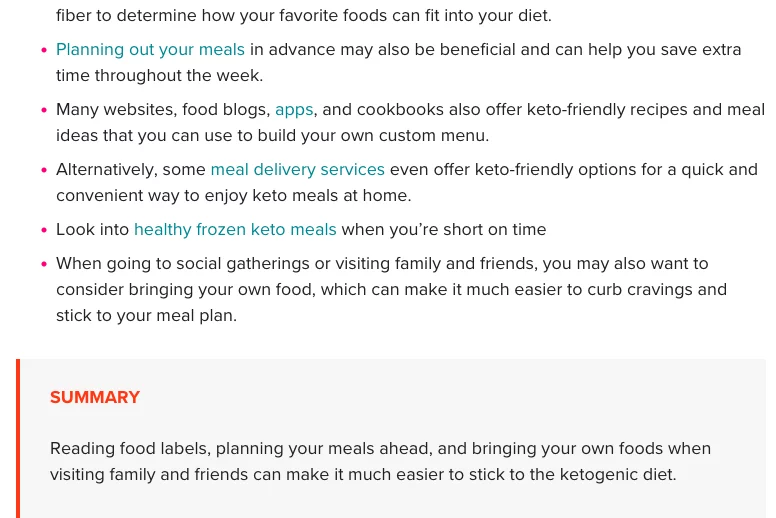
Example #3: Moz’s Beginner’s Guide to SEO
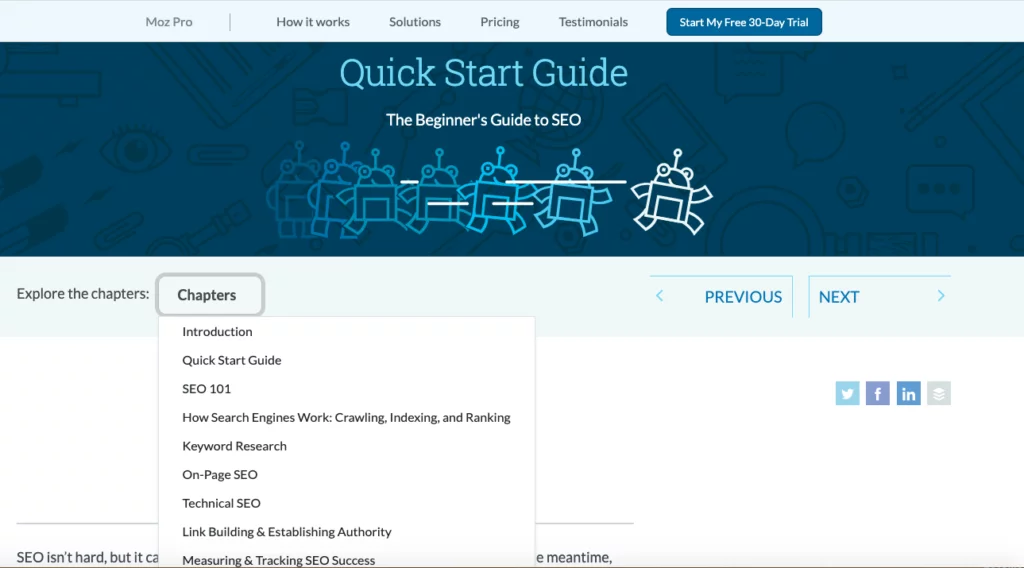
Moz’s Beginner’s Guide to SEO stands out as a quintessential example of cornerstone content within the digital marketing sphere. This comprehensive guide serves as a foundational resource for individuals looking to delve into the intricacies of search engine optimization (SEO), catering to both beginners and seasoned professionals alike.
- Comprehensive Structure: The guide is structured into individual chapters, each dedicated to a specific aspect of SEO, such as keyword research, on-page optimization, link building, and technical SEO. This organized approach facilitates systematic learning and allows readers to navigate through different topics with ease.
- Detailed Explanations: Within each chapter, Moz provides in-depth explanations and insights into the various elements of SEO, breaking down complex concepts into digestible chunks. The content is written in a clear and accessible manner, making it accessible to readers with varying levels of expertise.
- Strategic Internal Linking: Moz employs a strategic internal linking strategy throughout the guide, enhancing the user experience and facilitating further exploration of related topics. For instance, when discussing anchor text optimization, the guide seamlessly links out to additional resources or blog posts that provide more detailed information on the subject.
- Interactive Elements: The guide incorporates interactive elements, such as images, diagrams, and infographics, to complement the textual content and engage readers visually. These visual aids not only enhance comprehension but also break up the text, making it more visually appealing and easier to digest.
- Resource Library: Additionally, Moz’s guide serves as a gateway to a wealth of supplementary resources, including blog posts, tools, and case studies, which further enrich the learning experience. Readers can access additional insights and practical tips to deepen their understanding of SEO best practices.
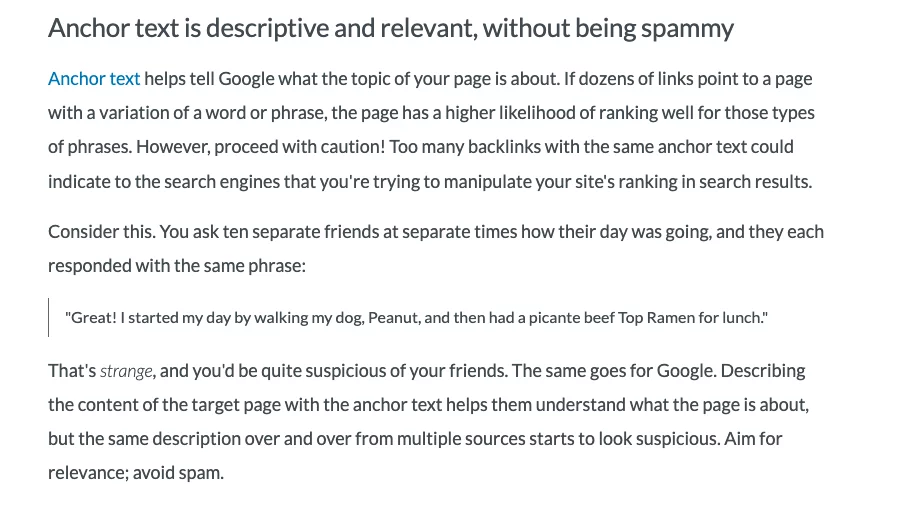
Example #4: HubSpot’s Guide to Creating a Sales Process
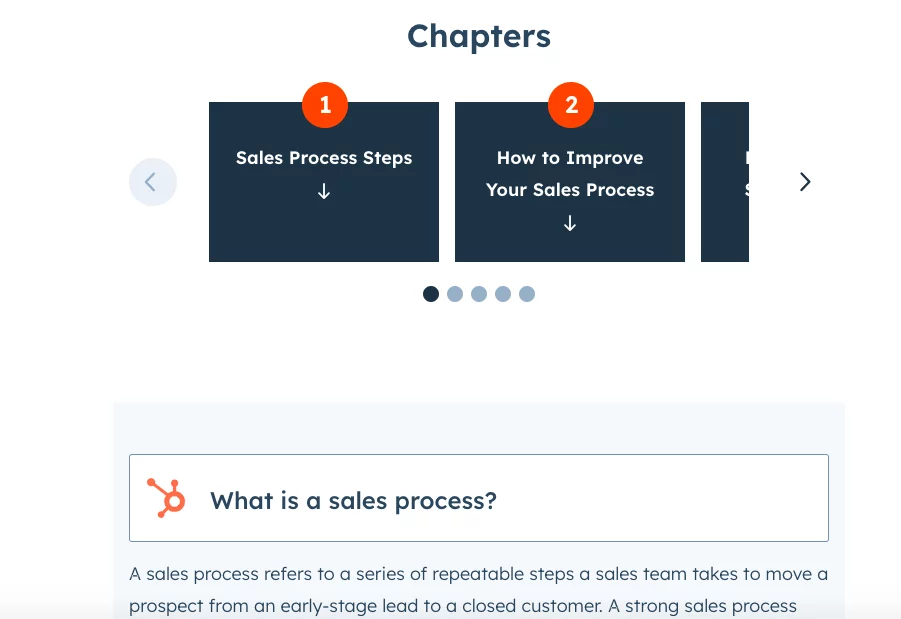
HubSpot’s Guide to Creating a Sales Process exemplifies cornerstone content aimed at assisting businesses in optimizing their sales strategies. This comprehensive guide offers a step-by-step approach to building an effective sales process, empowering organizations to streamline their operations and drive revenue growth.
- User-Friendly Design: The guide features a user-friendly design, with clear chapter divisions and intuitive navigation elements that make it easy for readers to navigate through the content. HubSpot employs a clean layout and visually appealing design elements to enhance the reading experience and maintain reader engagement.
- Structured Chapters: Each chapter of the guide is dedicated to a specific aspect of the sales process, such as prospecting, lead qualification, and closing techniques. This structured approach allows readers to focus on individual topics of interest or follow the guide sequentially to develop a comprehensive understanding of the entire sales cycle.
- Rich Content: HubSpot delivers rich, informative content within each chapter, providing practical insights, actionable tips, and real-world examples to illustrate key concepts. The guide combines text-based explanations with multimedia elements, including images, charts, and videos, to cater to diverse learning preferences and enhance comprehension.
- Strategic Internal Linking: Throughout the guide, HubSpot strategically integrates internal links to relevant blog posts, resources, and tools, offering readers access to additional information and resources to deepen their knowledge. By seamlessly connecting related topics within the guide, HubSpot encourages further exploration and engagement with its content ecosystem.
- Actionable Advice: HubSpot’s guide goes beyond theoretical concepts to provide actionable advice and best practices that businesses can implement to improve their sales performance. Whether it’s optimizing lead generation strategies or refining sales outreach tactics, the guide offers practical solutions to common sales challenges faced by organizations.
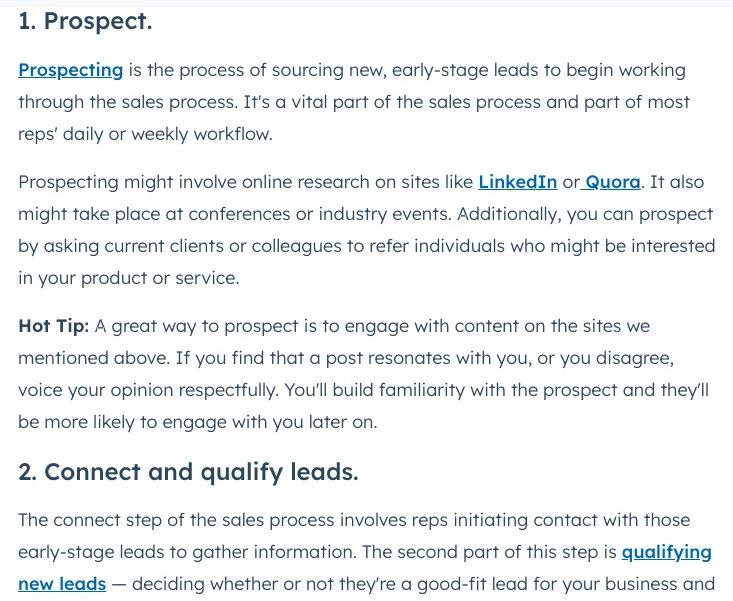
Conclusion:
Cornerstone content plays a pivotal role in digital marketing strategies, serving as foundational resources that anchor a website’s content ecosystem. Through comprehensive guides, in-depth articles, and strategic internal linking, cornerstone content establishes authority, enhances user experience, and drives organic traffic. Examples from industry leaders like Moz and HubSpot showcase how well-executed cornerstone content can educate, engage, and empower audiences while reinforcing a brand’s expertise in its niche.
FAQs on Cornerstone Content:
How long should cornerstone content be?
Cornerstone content typically ranges from 2,000 to 5,000 words or more, depending on the complexity of the topic and the level of detail required to provide valuable information. The focus should be on delivering comprehensive insights rather than meeting a specific word count.
How can I measure the effectiveness of cornerstone content?
Key performance indicators (KPIs) for measuring cornerstone content effectiveness include organic traffic, search engine rankings, backlinks earned, user engagement metrics (such as time on page and bounce rate), and conversions attributed to the content. Regular monitoring and analysis can help assess performance and inform optimization strategies.
Is cornerstone content suitable for all types of websites?
While cornerstone content is beneficial for many websites, its suitability depends on factors such as the website’s niche, audience, and content strategy. Websites aiming to establish authority on specific topics and improve SEO often benefit most from implementing cornerstone content strategies.



